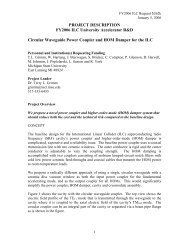A University Program of Accelerator and Detector Research for the ...
A University Program of Accelerator and Detector Research for the ...
A University Program of Accelerator and Detector Research for the ...
Create successful ePaper yourself
Turn your PDF publications into a flip-book with our unique Google optimized e-Paper software.
A <strong>University</strong> <strong>Program</strong> <strong>of</strong><strong>Accelerator</strong> <strong>and</strong> <strong>Detector</strong><strong>Research</strong> <strong>for</strong> <strong>the</strong>International LinearCollider (vol. III)FY 2005 – FY 2007<strong>University</strong> Consortium <strong>for</strong> Linear ColliderR&D<strong>and</strong>Linear Collider <strong>Research</strong> <strong>and</strong> DevelopmentWorking GroupApril 18, 2005G.D. Gollin, editor
This document is available electronically at http://www.hep.uiuc.edu/LCRD/.2
Executive SummaryIn <strong>the</strong> last several years, <strong>the</strong> international high energy physics community has come to aconsensus that <strong>the</strong> next large project should be a TeV-scale linear collider. In <strong>the</strong> U.S.this is evidenced by <strong>the</strong> consensus reached at <strong>the</strong> Snowmass 2001 workshop <strong>and</strong> <strong>the</strong>subsequent statement by HEPAP:We recommend that <strong>the</strong> highest priority <strong>of</strong> <strong>the</strong> U.S. program be ahigh-energy, high-luminosity, electron-positron linear collider,wherever it is built in <strong>the</strong> world. This facility is <strong>the</strong> next major step in<strong>the</strong> field <strong>and</strong> should be designed, built <strong>and</strong> operated as a fullyinternational ef<strong>for</strong>t.We also recommend that <strong>the</strong> United States take a leadershipposition in <strong>for</strong>ming <strong>the</strong> international collaboration needed to developa final design, build <strong>and</strong> operate this machine. The U.S.participation should be undertaken as a partnership between DOE<strong>and</strong> NSF, with <strong>the</strong> full involvement <strong>of</strong> <strong>the</strong> entire particle physicscommunity.... *This document is part <strong>of</strong> an ef<strong>for</strong>t to pursue a large-scale, national program <strong>of</strong> research<strong>and</strong> development leading to <strong>the</strong> design <strong>of</strong> <strong>the</strong> International Linear Collider. It has beenwritten by groups from a large number <strong>of</strong> universities in collaboration with national <strong>and</strong>industrial laboratories as well as <strong>for</strong>eign institutions. The proposed research is intended toextend <strong>the</strong> ongoing work being done at labs <strong>and</strong> universities around <strong>the</strong> world.The large participation <strong>and</strong> spontaneous assembly <strong>of</strong> many groups to <strong>for</strong>m this researchprogram expresses both <strong>the</strong> high level <strong>of</strong> interest in <strong>the</strong> university community toparticipate in this work <strong>and</strong> <strong>the</strong> desire to work toge<strong>the</strong>r in a coordinated fashion toaccomplish a common, important goal.The Department <strong>of</strong> Energy <strong>and</strong> <strong>the</strong> National Science Foundation are supportive <strong>of</strong>university participation in accelerator <strong>and</strong> detector projects <strong>for</strong> <strong>the</strong> ILC. From thisdocument, which describes a coherent national research program in a fashion independent<strong>of</strong> funding source, are derived <strong>the</strong> proposals submitted to <strong>the</strong> agencies in 2002, 2003, <strong>and</strong>2005.The authors have worked closely with <strong>the</strong> American Linear Collider Physics WorkingGroups <strong>and</strong> <strong>the</strong> laboratories doing accelerator research to ensure that <strong>the</strong> most importantissues were addressed.Nearly half <strong>the</strong> proposed work is related to advancing accelerator technology. This is achange from <strong>the</strong> recent past when <strong>the</strong> vast majority <strong>of</strong> high energy physics R&D workper<strong>for</strong>med at universities concerned detector development. In general, <strong>the</strong> critical pathaccelerator research needed <strong>for</strong> <strong>the</strong> International Linear Collider is already underway at* DOE/NSF High Energy Physics Advisory Panel Subpanel On Long Range Planning For U.S. High EnergyPhysics, january 2002. Their report is available at http://doe-hep.hep.net/lrp_panel/.3
<strong>the</strong> national laboratories. Some <strong>of</strong> <strong>the</strong> work proposed here supports <strong>the</strong>se critical pathitems. However, most <strong>of</strong> <strong>the</strong> proposed projects concentrate on <strong>the</strong> next level <strong>of</strong>development: issues that must be resolved in order to build <strong>the</strong> ILC in a timely fashion,based on a solid design <strong>and</strong> reliable cost estimates.There has been ongoing Linear Collider research <strong>and</strong> development work at laboratories<strong>and</strong> universities <strong>for</strong> <strong>the</strong> last twenty years. As <strong>the</strong> accelerator nears construction, moreresources will be needed to finalize its design. The work proposed here will not onlyaccomplish <strong>the</strong> short-term goals described above, but will also will train new scientists<strong>and</strong> engineers, contributing to <strong>the</strong> pool <strong>of</strong> talent <strong>and</strong> expertise that will be needed toaccomplish <strong>the</strong> large task <strong>of</strong> building <strong>the</strong> International Linear Collider accelerator <strong>and</strong>detector.4
<strong>University</strong> Consortium <strong>for</strong> Linear Collider R&D<strong>and</strong>Linear Collider <strong>Research</strong> <strong>and</strong> Development Working GroupJohn M. Butler, Meenakshi NarainBoston <strong>University</strong>Dept. <strong>of</strong> Physics, 590 Commonwealth Avenue, Boston, MA 02215 (1)[2]Richard PartridgeBrown <strong>University</strong>Dept. <strong>of</strong> Physics, Box 1843, Providence, RI 02912 (2)[1]Yury Kolomensky, Andrzej Wolski<strong>University</strong> <strong>of</strong> Cali<strong>for</strong>nia, Berkeley,Dept. <strong>of</strong> Physics, Berkeley, CA 94720 (3)[2]Maxwell Chertok, David E. Pellett, Mani Tripathi, Juan Lizarazo<strong>University</strong> <strong>of</strong> Cali<strong>for</strong>nia, DavisDept. <strong>of</strong> Physics, 1 Shields Avenue, Davis, CA 95616 (4)[4]David B. Cline, Yasuo Fukui, Feng Zhou<strong>University</strong> <strong>of</strong> Cali<strong>for</strong>nia, Los AngelesDept. <strong>of</strong> Physics <strong>and</strong> Astronomy, 405 Hilgard Ave., Los Angeles, CA 90095-1547 (5)[3]V. Nesterenko, H. P. Paar<strong>University</strong> <strong>of</strong> Cali<strong>for</strong>nia, San DiegoDepartment <strong>of</strong> Physics, 9500 Gilman Drive, La Jolla, CA 92093 (6)[2..14]Christian Flacco, Hartmut Sadrozinski, Bruce Schumm, Ned Spencer, Abraham Seiden,Alex Grillo, Jurgen Kroseberg, Gavin Nesom, Lucas Winstrom, Michael Young<strong>University</strong> <strong>of</strong> Cali<strong>for</strong>nia, Santa CruzDept. <strong>of</strong> Physics, Inst. <strong>for</strong> Particle Physics, Nat Sci 2, Santa Cruz, CA 95064 (7)[10]Mark Oreglia<strong>University</strong> <strong>of</strong> ChicagoThe Enrico Fermi Institute, 5640 South Ellis Avenue, Chicago, IL, 60637 (8)[1]5
Paul Beckingham, Uriel Nauenberg, Martin Nagel, Mat<strong>the</strong>w Phillips, Joseph Proulx,William Ruddick, Stephen R. Wagner, Shenjian Chen, Keith Drake, Eric Erdos, JeremiahGoodson, Jason Gray, Andrew Hahn, Alfonzo Martinez, Keith Miller, Jinlong Zhang<strong>University</strong> <strong>of</strong> ColoradoDept. <strong>of</strong> Physics, Boulder, CO 80309-0390 (9)[16..31]David Warner, Robert WilsonColorado State <strong>University</strong>Dept. <strong>of</strong> Physics, Fort Collins, CO 80523-1875 (10)[2]J. Alex<strong>and</strong>er, G. F. Dugan, R. S. Galik, M. Palmer, R. Patterson, D. P. Peterson, D.Rubin, D. Sagan, V. Shemelin, M. Tigner, T. WilksenCornell <strong>University</strong>Laboratory <strong>for</strong> Elementary Particle PhysicsIthaca, NY 14853-2501 (11)[11]Dave Winn, V. Podrasky, C. SanzeniFairfield <strong>University</strong>Dept. <strong>of</strong> Physics, Fairfield, CT, 06430 (12)[3..47]Sherwood Parker<strong>University</strong> <strong>of</strong> Hawaii at ManoaDept. <strong>of</strong> Physics <strong>and</strong> Astronomy, 2505 Correa Road, Honolulu, Hawai'i 96822 (13)[1]Guy Bresler 1 , Joseph Calvey 1 , A. Cortes 1 , Michael Davidsaver 1 , Keri Dixon 1 , G.D.Gollin 1 , M.J. Haney 1 , T.R. Junk 1 , W.D. O’Brien 2 , Justin Phillips 1 , Jeremy Williams 1<strong>University</strong> <strong>of</strong> Illinois at Urbana-Champaign1 Dept. <strong>of</strong> Physics, 1110 W. Green, Urbana, IL, 618012 Dept. <strong>of</strong> Electrical <strong>and</strong> Computer Engineering, 1406 W. Green, Urbana, IL, 61801(14)[11]Robert Abrams, Richard J. Van Kooten, Keith TurpinIndiana <strong>University</strong>Dept. <strong>of</strong> Physics, Swain West 117, Bloomington, IN, 47405 (15)[3]U. Akgun, A. S. Ayan, E. Berry, Mat<strong>the</strong>w J. Charles, K. Dolan, F. Duru, WolfgangMader, Usha Mallik, J. P. Merlo, A. Mestvirisvili, M. Miller, D. Monner, E. Norbeck,Jon Olson, Yasar Onel, I. Schmidt<strong>University</strong> <strong>of</strong> IowaDept. <strong>of</strong> Physics <strong>and</strong> Astronomy, Van Allen Hall, Iowa City, IA, 52242 (16)[16..78]Walter Anderson, Shauna Dennis, John Hauptman, Sam Ose, Robert Schoene, J. LamsaIowa State <strong>University</strong>Dept. <strong>of</strong> Physics <strong>and</strong> Astronomy, Ames, IA, 50011 (17)[6]6
Jonathan van Eenwyk, Darius Gallagher, Graham Wilson, Eric Benavidez, CarstenHensel<strong>University</strong> <strong>of</strong> KansasDept. <strong>of</strong> Physics <strong>and</strong> Astronomy, Lawrence, Kansas 66045 (18)[5..89]Tim Bolton, Dima Onoprienko, Eckhard von ToerneKansas State <strong>University</strong>Dept. <strong>of</strong> Physics, Manhattan, KS 66506-2601 (19)[+3]Lee Sawyer, Z. D. Greenwood, Tony ForestLouisiana Technical <strong>University</strong>Center <strong>for</strong> Applied Physics StudiesW Arizona Ave., Ruston, Louisiana 71272-0046 (20)[3]Ulrich Becker, Chiping Chen, Peter FisherMassachusetts Institute <strong>of</strong> TechnologyDept. <strong>of</strong> Physics, MIT 44-120, Cambridge, MA, 02139 (21)[3]S. Nyberg, K. Riles, H. Yang<strong>University</strong> <strong>of</strong> MichiganDept. <strong>of</strong> Physics, Univ. <strong>of</strong> Michigan, Ann Arbor, MI 48109 (22)[3]R. Poling, A. Smith<strong>University</strong> <strong>of</strong> MinnesotaDept. <strong>of</strong> Physics 116 Church Street S.E., Minneapolis, MN 55455 (23)[2]R. A. Schill, Jr.<strong>University</strong> <strong>of</strong> Nevada, Las VegasDepartment <strong>of</strong> Physics, Box 454002, 4505 Maryl<strong>and</strong> Parkway, Las Vegas, NV89154-4002 (24)[1]James Ellison, Gabriele Bassi, Klaus Heinemann<strong>University</strong> <strong>of</strong> New Mexico1 Dept. <strong>of</strong> Ma<strong>the</strong>matics <strong>and</strong> Statistics, Albuquerque, NM 87131 (25)[3]Jesse ErnstState <strong>University</strong> <strong>of</strong> New York at AlbanyDept. <strong>of</strong> Physics, 1400 Washington Ave., Albany, NY 12222 (26)[1]S. Danagoulian, S. MtingwaNorth Carolina A&T State <strong>University</strong>Dept. <strong>of</strong> Physics, 101 Marteena Hall, Greensboro, NC 27411 (27)[2..107]7
D. Beznosko, Gerald Blazey, Court Bohn, Dhiman Chakraborty, Alex<strong>and</strong>re Dychkant, K.Francis, David Hedin, J.G. Lima, Arthur Maciel, M. Martin, J. McCormick, V. Rykalin,V. ZutshiNor<strong>the</strong>rn Illinois <strong>University</strong>Dept. <strong>of</strong> Physics <strong>and</strong> Nor<strong>the</strong>rn Illinois Center <strong>for</strong> <strong>Accelerator</strong> <strong>and</strong> <strong>Detector</strong> Development,DeKalb, IL, 60115 (28)[13]Mayda Velasco, Armen Apyan, D. N. Seidman, Michael SzleperNorthwestern <strong>University</strong>Dept. <strong>of</strong> Physics <strong>and</strong> Astronomy, Evanston, IL, 60208-3112 (29)[4..124]Michael Hildreth, M. McKenna, Mitchell Wayne<strong>University</strong> <strong>of</strong> Notre DameDept. <strong>of</strong> Physics, 225 Nieuwl<strong>and</strong> Science Hall, Notre Dame, IN, 46556-5670 (30)[3]K. K. Gan , Mark Johnson, Richard Kass, J. Moore, Chuck RushOhio State <strong>University</strong>Dept. <strong>of</strong> Physics, 174 W 18th Ave, Columbus, OH, 43210 (31)[5]Michael G. Strauss<strong>University</strong> <strong>of</strong> OklahomaDept. <strong>of</strong> Physics, 440 West Brooks, Norman, OK, 73019 (32)[1]Leposava Vuskovic, S. Popovic, M. RaskovicOld Dominion <strong>University</strong>Department <strong>of</strong> Physics, 4600 Elkhorn Ave., Norfolk, VA 23529-0116 (33)[3]J. Brau, Raymond Frey, O. Igonkina, N. Sinev, D. Strom, Eric Torrence<strong>University</strong> <strong>of</strong> OregonDept. <strong>of</strong> Physics, 1371 E 13th Avenue, Eugene, OR 97403 (34)[6..142]Nigel Lockyer<strong>University</strong> <strong>of</strong> PennsylvaniaDepartment <strong>of</strong> Physics <strong>and</strong> Astronomy, 209 South 33rd Street, Philadelphia, PA19104-6396 (35)[1]M. StrikmanPennsylvania State <strong>University</strong>Davey Lab, <strong>University</strong> Park, PA 16802-6300 (36)[1]Changguo Lu, Kirk T. McDonaldPrinceton <strong>University</strong>Dept. <strong>of</strong> Physics, Princeton, NJ 08544 (37)[2]8
Kirk Arndt, G. Bolla, Alvin Laasanena, Abe Spinelli Virgil Barnes, Daniela Bortoletto, J.Miyamoto, Ian ShipseyPurdue <strong>University</strong>Dept. <strong>of</strong> Physics, 1396 Physics Department, West Lafayette, IN, 47907 (38)[8]P. Padley, M. Matveev, J. RobertsRice <strong>University</strong>Dept. <strong>of</strong> Physics <strong>and</strong> Astronomy, Houston, Texas 77251 (39)[3]William Bugg, Steve Berridge, Yury Efremenko, Thomas H<strong>and</strong>ler, Stefan Spanier, YuriKamyshkov<strong>University</strong> <strong>of</strong> TennesseeDept. <strong>of</strong> Physics, Univ. <strong>of</strong> Tennessee, Knoxville, TN, 37996-1200 (40)[6..163]Andrew Br<strong>and</strong>t, Kaushik De, Venkat Kaushik, Jia Li, Mark Sosebee, Andy White, JaeYu<strong>University</strong> <strong>of</strong> Texas at ArlingtonDept. <strong>of</strong> Physics, Box 19059, High Energy Physics, UTA, Arlington, TX, 76019 (41)[7]Karol Lang<strong>University</strong> <strong>of</strong> Texas at AustinDept. <strong>of</strong> Physics, RLM 5.208, Austin, TX, 78712 (42)[1]Nural Akchurin, H. Kim, R. WigmansTexas Technical <strong>University</strong>Dept. <strong>of</strong> Physics, MS 1051, Lubbock, Texas 79409 (43)[3]William P. OliverTufts <strong>University</strong>Dept. <strong>of</strong> Physics <strong>and</strong> Astronomy, Med<strong>for</strong>d, MA, 02155 (44)[1]S. Csorna 1 , B. Feng 2 , W. E. Gabella 2 , John Kozub 2 , Tamas Sashalmi 1V<strong>and</strong>erbilt <strong>University</strong>Dept. <strong>of</strong> Physics <strong>and</strong> Astronomy 1 , VU Station B 1807, Nashville, TN 37235W. M. Keck Foundation Free-Electron Laser Center 2 ,410 24th Avenue, Nashville, TN 37212 (45)[5..180]Tianchi Zhao<strong>University</strong> <strong>of</strong> WashingtonDepartment <strong>of</strong> Physics, Box 351560, Seattle, WA 98195-1560 (46)[+1]Ivan Avrutsky, Rene Bellwied, Giovanni Bonvicini, David Cinabro, Mikhail Dubrovin,Alfredo Gutierrez, Paul Karchin, Vladimir Rykov, Alex<strong>and</strong>er SchreinerWayne State <strong>University</strong>Dept. <strong>of</strong> Physics, 666 W. Hancock, Detroit, MI, 48202 (47)[9]9
Richard Prepost, D. Larbalestier, P. Lee, A. Polyanskii, A. Squitieri, A. Gurevich<strong>University</strong> <strong>of</strong> Wisconsin-MadisonDept. <strong>of</strong> Physics, 1150 <strong>University</strong> Ave., Madison, WI, 53706 (48)[6]C. Baltay 1 , W. Emmet 1 , J. Hirshfield 2 , H. Neal 1 , D. Rabinowitz 1Yale <strong>University</strong>Dept. <strong>of</strong> Physics, Sloane Physics Lab 1 , Beam Physics Laboratory 2217 Prospect Street, PO Box 208120, New Haven, CT 06520-8120 (49)[5..200]U.S. National Laboratories <strong>and</strong> IndustriesGary Drake, Wei Gai, John Power, José Repond, Dave Underwood, Barry Wicklund, LeiXia, S. Magill, J. Norem, Steve Kuhlman,Argonne National Laboratory9700 South Cass Avenue, Argonne, IL 60439 (1)[10]Alan Bross, David A. Finley, H. Eugene Fisk, James Fast, N. Graf, James H<strong>of</strong>f, MichaelHrycyk, C. Jensen, Kurt Krempetz, Caroline Milstene, Shekhar Mishra, Adam Para, OlegProk<strong>of</strong>iev, Vladimir Shiltsev, Ray Stefanski, Slawomir Tkaczyk, James T. Volk, WilliamWester, James Wolf, Nikolay Solyak, R. Yarema, Sten Hansen, Abderrezak Mekkaoui,Claudio Rivetta, Paul Rubinov, Tom Zimmerman, P. Bauer, L. Bellantoni, Bill Cooper,Marcel DemarteauFermi National <strong>Accelerator</strong> LaboratoryPO Box 500, Batavia, IL, 60510 (2)[30]A. Wolski, Marco BattagliaLawence Berkeley National LaboratoryBerkeley, CA 94720 (3)[2]Lars Ludeking, David Smi<strong>the</strong>Mission <strong>Research</strong> Corporation, Santa Barbara, CA (4)[2]O. A. Nezhevenko, V. YakovlevOmega P, Inc.199 Whitney Ave., New Haven, CT. (1)[2]Chris Adolphsen, Ray Arnold, Paul Bolton, M. Breidenbach, J. Clendenin, D. Freytag,Joe Frisch, E. Garwin, N. Graf, G. Haller, J. Jaros, R. Kirby, Thomas Markiewicz, T.Maruyama, O. Milgrome, Ken M<strong>of</strong>feit, R. Pitthan, Marc Ross, Steve Smith, James E.Spencer, Peter Tenenbaum, Stephen Wagner, Robert Warnock, Zachary R. Wolf,Michael Woods, Gordon BowdenStan<strong>for</strong>d Linear <strong>Accelerator</strong> Center2575 S<strong>and</strong> Hill Road, Menlo Park, CA, 94025 (5)[25]10
A.-M. Valente, L. PhillipsThomas Jefferson National <strong>Accelerator</strong> Facility12000 Jefferson Avenue, Newport News, VA 23606 (6)[2..71]Foreign Collaborating InstitutionsErhan GulmezBogazici <strong>University</strong>Dept. <strong>of</strong> Physics, Istanbul, Turkey (2)[1]Cinzia Da Via, Jasmine Hasi, Angela KokBrunel <strong>University</strong> (3)[3]E. V. KozyrevBudker Inst. <strong>of</strong> Nuclear PhysicsAcad. Lavrentiev prospect 11, 630090 Novosibirsk, Russia (4)[1]David Ward, Mark ThomsonCambridge <strong>University</strong>Cavendish Laboratory, Madingley Road, Cambridge CB3 OHE, United Kingdom (5)[2]Changhie HanChangwon National <strong>University</strong>9 Sarim-dong, Changwon, Kyongnam, 641-773, Korea (6)[1]Gulsen OnengutCukurova <strong>University</strong>Dept. <strong>of</strong> Physics, Adana, Turkey (7)[1]W. Decking, F. SefkowDESYNotkestr. 85, 22607 Hamburg, Germany (8)[2]Robert RossmanithForschungszentrum Karlsruhe, Germany (9)[1..12]Alex<strong>and</strong>er S. Aryshev, Pavel V. Karataev, K. Kubo, A. Miyamoto, Toshiya Muto, Y.Sugimoto, Makoto Tobiyama, Junji UrakawaKEK, High Energy <strong>Accelerator</strong> <strong>Research</strong> OrganizationTsukuba Science City, Japan (10)[8]11
J.E. Augustin, M. Baubillier, M. Berggren, C. Carimalo, Claude Chapton, W. Da Silva,Jean Francois Genat, Didier Imbault, F. Kapusta, Herve Lebbolo, Francois Rossel, A.Savoy-Navarro, Daniel VincentLPHNE, ParisFrance (11)[13]Ramazan SeverMETUDept. <strong>of</strong> Physics, Ankara, Turkey (12)[1]Vladimir AtramentovNIPTUkraine (13)[1]N. DelerueOx<strong>for</strong>dUnited Kingdom (14)[1..38]J.Y. HuangPAL POSTECHKorea (15)[1]G. Introzzi<strong>University</strong> <strong>of</strong> PaviaItaly (16)[1]C. DamerellRu<strong>the</strong>r<strong>for</strong>d Appleton LaboratoryChilton, DidcotOxon, UKOX11 0QX (17)[1]M. DaanilovInst <strong>of</strong> Theoretical <strong>and</strong> Experimental PhysicsBolshaya Cheremushkinskaya, 25, 117218 Moscow, Russia (18)[1]Hitoshi YamamotoTohoku <strong>University</strong>Japan (19)[1]Ryosuke Hamatsu, Pavel V. KarataevTokyo Metropolitan <strong>University</strong>Dept. <strong>of</strong> Physics, Tokyo, Japan (20)[2..45]Alex<strong>and</strong>er P. Potylitsyn, Gennady A. Naumenko, Alex<strong>and</strong>er S. Aryshev, A.Sharafutdinov12
Tomsk Polytechnic <strong>University</strong>Russia (21)[3]Aldo Penzo<strong>University</strong> <strong>of</strong> Trieste, INFN-TriesteDept. <strong>of</strong> Physics, Trieste Italy (22)[1]Li Jin, Yulan Li, Yongfang Lai, Yue QianTsinghua <strong>University</strong>China (23)[4]David Miller, Alex Ljapine<strong>University</strong> CollegeLondon, U.K. (24)[2..55]13
Table <strong>of</strong> ContentsExecutive Summary.............................................................................................................3Table <strong>of</strong> Contents...............................................................................................................151. Introduction: 21Introduction........................................................................................................................21Physics Goals at <strong>the</strong> International Linear Collider ............................................................22The Need <strong>for</strong> <strong>Detector</strong> <strong>and</strong> <strong>Accelerator</strong> R&D <strong>for</strong> <strong>the</strong> Linear Collider ..............................23<strong>University</strong> Participation in <strong>Accelerator</strong> <strong>and</strong> <strong>Detector</strong> <strong>Research</strong> <strong>and</strong> Development...........24Structure <strong>of</strong> <strong>the</strong> Document <strong>and</strong> Coordination Between LCRD <strong>and</strong> UCLC.......................262. <strong>Accelerator</strong> Physics: 28Overview <strong>and</strong> contents.......................................................................................................292.2 Beam Test Proposal <strong>of</strong> an Optical Diffraction Radiation Beam Size Monitor at <strong>the</strong>SLAC FFTB (Yasuo Fukui: progress report) ....................................................................342.3 Design <strong>and</strong> Fabrication <strong>of</strong> a Radiation-Hard 500-MHz Digitizer Using DeepSubmicron Technology (K.K. Gan: progress report).........................................................422.4 RF Beam Position Monitors <strong>for</strong> Measuring Beam Position <strong>and</strong> Tilt (YuryKolomensky: progress report)............................................................................................472.5 Non-intercepting electron beam diagnosis using diffraction radiation (Bibo Feng:renewal)..............................................................................................................................542.6 Electro-optic measurement <strong>of</strong> picosecond bunches in a bunch train (Bill Gabella:renewal)..............................................................................................................................622.7 Design <strong>for</strong> a Fast Synchrotron Radiation Imaging System <strong>for</strong> Beam Size Monitoring(Jim Alex<strong>and</strong>er: renewal)...................................................................................................682.9 Radiation damage studies <strong>of</strong> materials <strong>and</strong> electronic devices using hadrons (DavidPellett: progress report)......................................................................................................7415
2.10 BACKGAMMMON: A Scheme <strong>for</strong> Compton Backscattered Photoproduction at <strong>the</strong>International Linear Collider (S. Mtingwa: new proposal)................................................822.11 Ground Motion studies at NuMI (Mayda Velasco: new proposal)...........................902.15 Investigation <strong>of</strong> acoustic localization <strong>of</strong> rf cavity breakdown (George Gollin:progress report) ..................................................................................................................962.18 Control <strong>of</strong> Beam Loss in High-Repetition Rate High-Power PPM Klystrons(Chiping Chen: progress report) ......................................................................................1082.22 Investigation <strong>of</strong> Novel Schemes <strong>for</strong> Injection/Extraction Kickers (George Gollin:progress report) ................................................................................................................1162.25 Investigation <strong>and</strong> prototyping <strong>of</strong> fast kicker options <strong>for</strong> <strong>the</strong> TESLA damping rings(Gerry Dugan: progress report)........................................................................................1582.26 Continuing <strong>Research</strong> <strong>and</strong> Development <strong>of</strong> Linac <strong>and</strong> Final Doublet Girder Movers(David Warner: new proposal)........................................................................................1702.27 Effects <strong>of</strong> CSR in Linear Collider Systems: A Progress Report (James Ellison:progress report) ................................................................................................................1792.30 Beam simulation: main beam transport in <strong>the</strong> linacs <strong>and</strong> beam delivery systems,beam halo modeling <strong>and</strong> transport, <strong>and</strong> implementation as a diagnostic tool <strong>for</strong>commissioning <strong>and</strong> operation (Dave Rubin: progress report) .........................................1872.32 Supplementary Damping Systems <strong>for</strong> <strong>the</strong> International Linear Collider (S.Mtingwa: renewal)...........................................................................................................1922.34 Experimental, simulation, <strong>and</strong> design studies <strong>for</strong> linear collider damping rings(Gerry Dugan: renewal) ...................................................................................................1992.37 Demonstration <strong>of</strong> Undulator-Based Production <strong>of</strong> Polarized Positrons at FFTB atSLAC (William Bugg: progress report)...........................................................................2082.40 Development <strong>of</strong> Polarized Photocathodes <strong>for</strong> <strong>the</strong> Linear Collider (Richard Prepost:progress report) ................................................................................................................2252.43 Investigation <strong>of</strong> acoustic localization <strong>of</strong> rf coupler breakdown (Jeremy Williams:new proposal)...................................................................................................................2362.44 20-MW Magnicon <strong>for</strong> ILC (J.L. Hirshfield: new proposal) ...................................2472.45 SCRF Low-Level RF (LLRF) Development <strong>for</strong> ILC-SMTF (Nigel Lockyer: newproposal) ..........................................................................................................................26316
2.46 Polarized Positron Sources (Mayda Velasco: new proposal) .................................2692.47 Magnetic Investigation <strong>of</strong> High Purity Niobium <strong>for</strong> Superconducting RF Cavities(P. Lee: new proposal) .....................................................................................................2762.48 3D Atom-Probe Microscopy on Niobium <strong>for</strong> SRF Cavities (D.N. Seidman: newproposal) ..........................................................................................................................2842.49 Experimental Study <strong>of</strong> High Field Limits <strong>of</strong> RF Cavities (D.N. Seidman: newproposal) ..........................................................................................................................2942.50 Evaluation <strong>of</strong> MgB2 <strong>for</strong> Future <strong>Accelerator</strong> Cavities (V. Nesterenko: new proposal)3062.51 Investigation <strong>of</strong> Secondary Electron Emission from Nb Surfaces with DifferentSurface Treatments (Robert Schill: new proposal)..........................................................3152.52 Investigation <strong>of</strong> Plasma Etching <strong>for</strong> Superconducting RF Cavities surfacePreparation (Leposava Vuskovic: new proposal) ............................................................326<strong>Detector</strong> R&D Project Summary <strong>and</strong> Overview <strong>of</strong> Project Descriptions: 3343. Luminosity, Energy, Polarization: 340Overview <strong>and</strong> contents.....................................................................................................3413.1 A Fast Gas Cerenkov Calorimeter <strong>for</strong> Luminosity Measurement <strong>and</strong> MachineMonitoring (John Hauptman: renewal)............................................................................3443.2 R&D <strong>for</strong> luminosity monitor (Yasar Onel: new proposal) .......................................3523.4 Extraction Line Energy Spectrometer (Eric Torrence: renewal) ..............................3593.5 A Demonstration <strong>of</strong> <strong>the</strong> Electronic <strong>and</strong> Mechanical Stability <strong>of</strong> a BPM-Based EnergySpectrometer <strong>for</strong> <strong>the</strong> International Linear Collider (Mike Hildreth: new proposal)........3673.6 Polarimetry at LC (Yasar Onel: new proposal) ........................................................3773.7 Compton polarimeter backgrounds (William Oliver: renewal)................................3843.8 Incoherent <strong>and</strong> coherent beamstrahlung at <strong>the</strong> LC (Giovanni Bonvicini: renewal) .3903.9 Development <strong>of</strong> radiation hard, 3d-electrode array, silicon radiation sensors(Sherwood Parker: new proposal)....................................................................................40317
3.10 Beam-Diagnostic TPC (BDTPC) (Mike Ronan: new proposal).............................4124. Vertex <strong>Detector</strong>: 418Overview <strong>and</strong> contents.....................................................................................................4194.1 Pixel Vertex <strong>Detector</strong> R&D <strong>for</strong> Future High Energy Linear e+ e- Colliders (CharlieBaltay: renewal)...............................................................................................................4205. Tracking: 432Overview <strong>and</strong> contents.....................................................................................................4335.1 Development <strong>and</strong> Evaluation <strong>of</strong> Forward Tracking in <strong>the</strong> Linear Collider (MichaelStrauss: new proposal) .....................................................................................................4375.2 Development <strong>of</strong> a GEM based Forward Tracking Prototype <strong>for</strong> <strong>the</strong> ILC (Lee Sawyer:renewal)............................................................................................................................4435.4 Studies <strong>of</strong> Gas Electron Multipliers <strong>for</strong> a Time Projection Chamber <strong>for</strong> <strong>the</strong>International Linear Collider (Peter Fisher: renewal)......................................................4545.7 Development <strong>of</strong> a Micro Pattern Gas <strong>Detector</strong> Readout <strong>for</strong> a TPC (Dan Peterson:new proposal)...................................................................................................................4635.8 Linear Collider Tracker Simulation Studies <strong>and</strong> Alignment System R&D (KeithRiles: renewal) .................................................................................................................4785.10 R& D Towards a Long Shaping-Time Silicon Strip Central Tracker (BruceSchumm: renewal) ...........................................................................................................4885.13 Continuation <strong>of</strong> Reconstruction Studies <strong>for</strong> <strong>the</strong> SiD Barrel Outer Tracker (StephenWagner: new proposal)....................................................................................................4995.14 Simulation Studies <strong>for</strong> a Silicon Tracker (Richard Partridge: new proposal) .......5035.15 Calorimeter-based Tracking <strong>for</strong> Particle Flow <strong>and</strong> Reconstruction <strong>of</strong> Long-livedParticles with SiD <strong>Detector</strong> (Eckhard von Toerne: new proposal)..................................5095.16 TPC VLSI Readout R&D (Marco Battaglia: new proposal) ..................................5185.17 Development <strong>of</strong> thin silicon sensors <strong>for</strong> tracking (Daniela Bortoletto: new proposal)..........................................................................................................................................52418
6. Calorimetry: 533Overview <strong>and</strong> contents.....................................................................................................5346.1 Design <strong>and</strong> Prototyping <strong>of</strong> a Scintillator-based Semi-Digital Hadron Calorimeter(Vishnu Zutshi: renewal) .................................................................................................5386.2 Calorimetry R&D at Colorado: Progress Report <strong>of</strong> Work in 2004 <strong>and</strong> Proposed Work<strong>for</strong> 2005, 2006, 2007 (Uriel Nauenberg: renewal)...........................................................5496.4 Particle Flow Studies with <strong>the</strong> Silicon <strong>Detector</strong> (SiD) at <strong>the</strong> International LinearCollider (ILC) (Usha Mallik: renewal)............................................................................5666.5 Development <strong>of</strong> a silicon-tungsten test module <strong>for</strong> an electromagnetic calorimeter(Raymond Frey: renewal) ................................................................................................5816.6 Digital Hadron Calorimetry <strong>for</strong> <strong>the</strong> Linear Collider using GEM based Technology(Andy White: renewal) ....................................................................................................5916.9 Development <strong>of</strong> Particle-Flow Algorithms <strong>and</strong> Simulation S<strong>of</strong>tware <strong>for</strong> <strong>the</strong> ILC<strong>Detector</strong>(s) (Dhiman Chakraborty: renewal) ...................................................................6026.10 Investigation <strong>of</strong> ECAL Concepts Designed <strong>for</strong> Particle Flow (Graham Wilson: newproposal) ..........................................................................................................................6136.14 Construction <strong>of</strong> a Prototype Hadronic Calorimeter with Digital Readout (JoséRepond: new proposal) ....................................................................................................6246.16 Dual-Readout Calorimetry <strong>for</strong> <strong>the</strong> ILC (Richard Wigmans: new proposal)...........6346.17 Ultimate Hadron Calorimetry (Richard Wigmans: new proposal).........................6447. Muon System: 652Overview <strong>and</strong> contents.....................................................................................................6537.2 Scintillator Based Muon System R&D: 3-Year Proposal (Paul Karchin: renewal) .6557.5 Continuing Studies <strong>of</strong> Geiger-Mode Avalanche Photodiodes <strong>for</strong> Linear Collider<strong>Detector</strong> Muon System Readout (Robert J. Wilson: renewal).........................................6737.6 Design <strong>and</strong> Prototyping <strong>of</strong> a Scintillator-based Tail-catcher/Muon Tracker (VishnuZutshi: new proposal) ......................................................................................................67919
Appendix <strong>and</strong> References: 688Appendix: Participation Data <strong>and</strong> Indices; Reference.....................................................68820
IntroductionA worldwide consensus that <strong>the</strong> next large facility in particle physics should be aninternational high energy electron-positron collider has emerged in <strong>the</strong> last several years.The strong recommendation from <strong>the</strong> U.S. High Energy Physics Advisory Panel that ahigh energy, high-luminosity, electron-positron linear collider be <strong>the</strong> highest priority <strong>of</strong><strong>the</strong> U. S. program was paralleled in Europe <strong>and</strong> Asia. Each region recognized <strong>the</strong> centralimportance <strong>of</strong> <strong>the</strong> physics to be studied, as well as <strong>the</strong> maturity <strong>of</strong> accelerator designsbeing simultaneously advanced (<strong>and</strong> proposed) at laboratories in <strong>the</strong> United States,Germany, <strong>and</strong> Japan, <strong>and</strong> <strong>the</strong> necessity <strong>for</strong> international cooperation.Response to this consensus has been swift. Regional Steering Committees, charged withorganizing <strong>and</strong> coordinating Linear Collider activities in Asia, Europe, <strong>and</strong> <strong>the</strong> Americas,have been <strong>for</strong>med, as has <strong>the</strong>ir international counterpart, <strong>the</strong> International Linear ColliderSteering Committee. Under <strong>the</strong> auspices <strong>of</strong> <strong>the</strong> ILCSC, technical reviews <strong>of</strong> <strong>the</strong> twocompeting collider technologies have been completed <strong>and</strong> an International TechnologyRecommendation Panel recommended <strong>the</strong> development <strong>of</strong> <strong>the</strong> superconducting design.At <strong>the</strong> national level, <strong>the</strong> U.S. Department <strong>of</strong> Energy announced inclusion <strong>of</strong> <strong>the</strong> LinearCollider in its 20 year plan <strong>for</strong> new facilities, according it highest priority among <strong>the</strong> midtermprojects under consideration.The response from <strong>the</strong> U.S. High Energy Physics community has been equally swift. Inearly 2002, physicists from U.S. universities <strong>and</strong> laboratories organized a series <strong>of</strong>workshops at Chicago, Fermilab, Cornell, SLAC, <strong>and</strong> U.C. Santa Cruz aimed atunderst<strong>and</strong>ing fruitful directions <strong>for</strong> research <strong>and</strong> collaboration towards <strong>the</strong> LinearCollider. The hundreds <strong>of</strong> technical issues involved in <strong>the</strong> design <strong>and</strong> construction <strong>of</strong> <strong>the</strong>accelerator <strong>and</strong> detector emerged as an organizing <strong>the</strong>me. The <strong>University</strong> Consortium <strong>for</strong>Linear Collider R&D (UCLC) organized itself to consider <strong>the</strong>se issues in <strong>the</strong> context <strong>of</strong>NSF support, <strong>and</strong> <strong>the</strong> Linear Collider <strong>Research</strong> <strong>and</strong> Development Working Group(LCRD) did likewise in <strong>the</strong> context <strong>of</strong> DOE support. The two groups are naturallyintermingled with each o<strong>the</strong>r, <strong>and</strong> with <strong>the</strong> preexisting American Linear Collider PhysicsGroup (ALCPG). All concerned are working toge<strong>the</strong>r to coordinate <strong>the</strong>ir activities to <strong>the</strong>single task <strong>of</strong> building <strong>the</strong> linear collider.The result was <strong>the</strong> production <strong>of</strong> a joint UCLC/LCRD document, A <strong>University</strong> <strong>Program</strong><strong>of</strong> <strong>Accelerator</strong> <strong>and</strong> <strong>Detector</strong> <strong>Research</strong> <strong>for</strong> <strong>the</strong> Linear Collider, which collected <strong>the</strong>combined NSF <strong>and</strong> DOE proposals into a single program <strong>for</strong> LC related R&D. TheWorking Groups <strong>of</strong> <strong>the</strong> American Linear Collider Physics Group provided guidance,coordination, <strong>and</strong> advice to <strong>the</strong> individual proponents <strong>of</strong> both detector <strong>and</strong> acceleratorR&D. They were joined by an ad hoc <strong>Accelerator</strong> Working Group that did <strong>the</strong> same <strong>for</strong><strong>the</strong> accelerator proposals. In all, 71 proposals were collected from 47 U.S. universities,which addressed <strong>the</strong> full range <strong>of</strong> detector <strong>and</strong> machine/detector interface concerns, <strong>and</strong>complemented existing accelerator R&D ef<strong>for</strong>ts. A group <strong>of</strong> UCLC <strong>and</strong> LCRDorganizers assembled a coherent document that was submitted <strong>for</strong> rigorous review toseparate <strong>Detector</strong> <strong>and</strong> <strong>Accelerator</strong> Review Panels which met at Fermilab in21
September, 2002. After allowing <strong>for</strong> minor changes in <strong>the</strong> sub-proposals in response tocomments from <strong>the</strong> reviewers, <strong>the</strong> UCLC /LCRD organizers assembled <strong>the</strong> finaldocument on October, 22, 2002, <strong>and</strong> <strong>the</strong>n <strong>for</strong>mally submitted it to <strong>the</strong> NSF <strong>and</strong> DOE.DOE funded <strong>the</strong> highest ranked detector R&D sub-proposals in March, 2003, <strong>and</strong>, afterfur<strong>the</strong>r internal review, <strong>the</strong> chosen accelerator proposals in May. Roughly $400k wasallotted to each <strong>of</strong> detector <strong>and</strong> accelerator R&D. The NSF began funding <strong>the</strong> UCLCconsortium with $150k in late Spring, with <strong>the</strong> underst<strong>and</strong>ing that <strong>the</strong> full proposalshould be resubmitted <strong>for</strong> reconsideration early in <strong>the</strong> FY04 budget process.The following year, Volume II <strong>of</strong> A <strong>University</strong> <strong>Program</strong> <strong>of</strong> <strong>Accelerator</strong> <strong>and</strong> <strong>Detector</strong><strong>Research</strong> <strong>for</strong> <strong>the</strong> Linear Collider, presented <strong>the</strong> continuation <strong>of</strong> <strong>the</strong> Linear Collider R&Dproposal process <strong>for</strong> FY04. As in year one, it described a nationally coordinated program<strong>of</strong> university based linear collider research reaching across both funding agencies. FortyeightU.S. universities from 25 states, working with five national <strong>and</strong> industrial labs <strong>and</strong>eleven <strong>for</strong>eign institutions, wrote 68 proposals in a broad coverage <strong>of</strong> <strong>the</strong> previouslyidentified R&D needs <strong>of</strong> <strong>the</strong> linear collider. <strong>Accelerator</strong> R&D maintained <strong>the</strong> prominentrole it took in Volume I.The present volume continues this program, describing <strong>the</strong> progress <strong>of</strong> projects that hadreceived multiple-year funding, as well as presenting new proposals to <strong>the</strong> fundingagencies. There are a variety <strong>of</strong> administrative differences in <strong>the</strong> proposal process thisyear: most notably that DOE <strong>and</strong> NSF are going to share a common panel <strong>of</strong> reviewers inorder to increase <strong>the</strong> efficiency <strong>of</strong> <strong>the</strong> proposal process.The agencies have asked that new proposals consider a three-year horizon. Within thistime frame, key detector <strong>and</strong> accelerator R&D issues critical to <strong>the</strong> success <strong>of</strong> <strong>the</strong> LinearCollider will be addressed, <strong>and</strong> a growing community <strong>of</strong> high energy physicists will beinitiated into <strong>the</strong> study <strong>of</strong> physics at <strong>the</strong> Linear Collider.Physics Goals at <strong>the</strong> International Linear ColliderThe physics goals <strong>of</strong> <strong>the</strong> Linear Collider are ambitious <strong>and</strong> compelling. The LinearCollider is needed to address <strong>the</strong> central issue in particle physics today, <strong>the</strong> origin <strong>of</strong> mass<strong>and</strong> electroweak symmetry breaking. Over <strong>the</strong> past decade, a wide variety <strong>of</strong> experimentshas shown that elementary particle interactions at <strong>the</strong> TeV scale are dictated by anSU(3)×SU(2)×U(1) gauge symmetry. The non-zero masses <strong>of</strong> <strong>the</strong> W <strong>and</strong> Z particlesimply, however, that <strong>the</strong> electroweak SU(2)×U(1) symmetry is broken spontaneously. Wedo not know how <strong>the</strong> symmetry is broken, <strong>and</strong> we will not know until <strong>the</strong> agents <strong>of</strong>electroweak symmetry are produced directly in <strong>the</strong> laboratory <strong>and</strong>, also, are studied inprecise detail. But we have every reason to believe that whatever is responsible <strong>for</strong>electroweak symmetry breaking will be accessible at <strong>the</strong> Linear Collider.Although we do not know <strong>the</strong> mechanism <strong>of</strong> electroweak symmetry breaking, we havesome good hypo<strong>the</strong>ses. In <strong>the</strong> so-called St<strong>and</strong>ard Model, one doublet <strong>of</strong> scalar fieldsbreaks <strong>the</strong> symmetry. This model has one physical Higgs particle, which is <strong>the</strong> window toelectroweak symmetry breaking. The global consistency <strong>of</strong> precision electroweak22
measurements gives this model credence, <strong>and</strong> suggests that <strong>the</strong> Higgs boson is relativelylight, m H ≤ 200 GeV. However, we know this model does not work well beyond TeVenergies. A <strong>the</strong>oretically preferable scenario is based on supersymmetry (SUSY) at <strong>the</strong>expense <strong>of</strong> a whole new spectrum <strong>of</strong> fundamental particles <strong>and</strong> at least five Higgs states.But <strong>the</strong> lightest <strong>of</strong> <strong>the</strong>se states looks much like <strong>the</strong> St<strong>and</strong>ard Model Higgs, with nearlyst<strong>and</strong>ard model couplings <strong>and</strong> a mass less than 200 GeV or so. Nature may breakelectroweak symmetry through some o<strong>the</strong>r mechanism, <strong>of</strong> course, but most realisticmechanisms we have imagined result in a Higgs boson or some related phenomenaaccessible to <strong>the</strong> Linear Collider.The TeV scale is <strong>the</strong> natural place to look <strong>for</strong> <strong>the</strong> agents <strong>of</strong> electroweak symmetrybreaking. Thus, <strong>the</strong> ongoing Run 2 at Fermilab's Tevatron has a chance <strong>of</strong> getting <strong>the</strong> firstglimpses <strong>of</strong> <strong>the</strong>se phenomena. Starting later in <strong>the</strong> decade, CERN's LHC, with seventimes <strong>the</strong> energy, will almost certainly observe <strong>the</strong> Higgs boson, <strong>and</strong> has a very goodchance <strong>of</strong> discovering something else. Most high-energy physicists believe, however, that<strong>the</strong> LHC will not unravel <strong>the</strong> mysteries <strong>of</strong> symmetry breaking on its own.Experimentation at a linear e + e - collider (LC) provides in<strong>for</strong>mation that cannot beobtained by o<strong>the</strong>r means. Let us just cite two examples. First, a series <strong>of</strong> cross section <strong>and</strong>branching ratio measurements will trace out a detailed pr<strong>of</strong>ile <strong>of</strong> <strong>the</strong> Higgs boson, in amodel-independent way, <strong>and</strong> incisively test whe<strong>the</strong>r its couplings are proportional tomass. Second, if SUSY is at play, <strong>the</strong> LC can determine <strong>the</strong> lightest superpartners' masseswith exquisite precision. Since <strong>the</strong> LHC measures mass differences more precisely than<strong>the</strong> masses <strong>the</strong>mselves, one sees that a single LC measurement will significantly improve<strong>and</strong> extend <strong>the</strong> whole program <strong>of</strong> SUSY measurements at <strong>the</strong> LHC. In both <strong>the</strong>se cases,<strong>the</strong> Linear Collider adds critical in<strong>for</strong>mation to what will be learned at LHC. The LinearCollider is <strong>the</strong> right next step <strong>for</strong> experimental high energy physics, <strong>and</strong> now is <strong>the</strong> timeto take it in order to maximize <strong>the</strong> interplay <strong>of</strong> its results with those <strong>of</strong> <strong>the</strong> LHC.The full scientific case <strong>for</strong> <strong>the</strong> Linear Collider can be found in <strong>the</strong> Resource Bookprepared <strong>for</strong> Snowmass 2001 or <strong>the</strong> physics chapter <strong>of</strong> <strong>the</strong> Tesla Technical DesignReport. We believe <strong>the</strong> essential elements <strong>of</strong> <strong>the</strong> physics case have been madepersuasively, <strong>and</strong> we are responding by b<strong>and</strong>ing toge<strong>the</strong>r to meet <strong>the</strong> technical challengesthat remain, so that <strong>the</strong> device can be built in a timely <strong>and</strong> cost-effective fashion.The Need <strong>for</strong> <strong>Detector</strong> <strong>and</strong> <strong>Accelerator</strong> R&D <strong>for</strong> <strong>the</strong> Linear ColliderThe physics goals <strong>of</strong> <strong>the</strong> Linear Collider require a starting energy <strong>of</strong> 500 GeV,upgradeable to 1 TeV or more <strong>and</strong> a luminosity <strong>of</strong> about 2 × 10 34 cm -2 s -1 , an ambitiousfour orders <strong>of</strong> magnitude larger than <strong>the</strong> luminosity achieved by <strong>the</strong> first linear collider,<strong>the</strong> SLC. Achieving <strong>the</strong> high energy <strong>and</strong> ultra-low emittance <strong>of</strong> <strong>the</strong> Linear Colliderrequires significant advances in accelerator physics <strong>and</strong> technology: end-to-endsimulation <strong>of</strong> <strong>the</strong> entire accelerator complex; mastery <strong>of</strong> <strong>the</strong> consequences <strong>of</strong> strongwakes; ultra-fast beam manipulation; nanometer stability <strong>of</strong> <strong>the</strong> beams at <strong>the</strong> crossingpoint; extreme stability in beam energy, luminosity <strong>and</strong> polarization; h<strong>and</strong>lingunprecedented beam power; <strong>and</strong> <strong>the</strong> development <strong>of</strong> instrumentation to monitor <strong>the</strong> beamon a bunch-by-bunch basis. A construction start in 2010 requires that <strong>the</strong> basic R&D23
equired <strong>for</strong> a full technical design be complete by 2006. Much R&D remains to be done,<strong>and</strong> is urgently needed. The International Linear Collider Technical Review Committeeconcluded its 2003 report with a list <strong>of</strong> high priority R&D items in <strong>the</strong> areas <strong>of</strong>:accelerator simulation <strong>and</strong> design; accelerator experiments; <strong>the</strong> development <strong>and</strong> test <strong>of</strong>radio-frequency systems, instrumentation, <strong>and</strong> o<strong>the</strong>r hardware; <strong>and</strong> operational issues.To exploit <strong>the</strong> full physics potential <strong>of</strong> a 500 GeV Linear Collider, <strong>the</strong> detector mustmove well beyond <strong>the</strong> designs <strong>of</strong> <strong>the</strong> LEP/SLC era, <strong>and</strong> beyond <strong>the</strong> current state <strong>of</strong> <strong>the</strong>art. The detector development which has gone on in preparation <strong>for</strong> <strong>the</strong> LHC experimentshas certainly advanced <strong>the</strong> art, particularly in terms <strong>of</strong> extreme rate capability <strong>and</strong>radiation hardness, <strong>and</strong> also in terms <strong>of</strong> dealing with <strong>the</strong> TeV energy scale in tracking <strong>and</strong>calorimetry. But it has not pushed detector per<strong>for</strong>mance to <strong>the</strong> level required <strong>for</strong> highprecision measurements at <strong>the</strong> LC, or to <strong>the</strong> level allowed by <strong>the</strong> very differentexperimental environment found at <strong>the</strong> LC: low event rates, a relatively benign radiationfield, <strong>and</strong> events clean from <strong>the</strong> debris <strong>of</strong> <strong>the</strong> underlying event or multiple interactions.R&D is required <strong>for</strong> each <strong>of</strong> <strong>the</strong> major detector subsystems. High per<strong>for</strong>mance vertexdetection is a necessity at <strong>the</strong> LC, to extract <strong>the</strong> full precision from measurements <strong>of</strong> <strong>the</strong>Higgs branching fractions into b quarks, c quarks, <strong>and</strong> gluons. Development is needed toboost CCD readout speeds <strong>and</strong> radiation hardness <strong>and</strong>/or to develop fast, thin, highresolution alternatives. Very high momentum resolution in <strong>the</strong> tracking detector, whichwill permit <strong>the</strong> Higgs to be tagged in recoil with a Z, will require new readout techniques<strong>and</strong> improved spatial resolution in <strong>the</strong> TPC, or precision alignment in a silicon tracker.Fur<strong>the</strong>r studies are needed to guarantee full coverage in <strong>the</strong> <strong>for</strong>ward region, to studybackgrounds <strong>and</strong> thinning requirements <strong>and</strong> evaluate pattern recognition capabilities <strong>for</strong>different designs. LC calorimeters must distinguish W <strong>and</strong> Z bosons, <strong>and</strong> improve energyresolution by a factor <strong>of</strong> two over today’s designs. Energy flow calorimetry must be fullysimulated <strong>and</strong> detector parameters optimized. Since lepton ID involves <strong>the</strong> interplay <strong>of</strong><strong>the</strong> tracking detector <strong>and</strong> both <strong>the</strong> electromagnetic <strong>and</strong> hadronic calorimeters, overallsystem per<strong>for</strong>mance must be evaluated <strong>and</strong> optimized. The case <strong>for</strong> hadron ID, besides itsobvious application <strong>for</strong> quark flavor tagging in Giga-Z running, hasn’t yet been made, soit needs fur<strong>the</strong>r study. Precision threshold measurements will depend on a determination<strong>of</strong> <strong>the</strong> machine energy to an accuracy well beyond what has been so far achieved <strong>and</strong>precise knowledge <strong>of</strong> <strong>the</strong> differential luminosity spectrum, a new variable at colliders.<strong>University</strong> Participation in <strong>Accelerator</strong> <strong>and</strong> <strong>Detector</strong> <strong>Research</strong> <strong>and</strong> DevelopmentThe community <strong>of</strong> High Energy Physics experimentalists, as well as o<strong>the</strong>r members <strong>of</strong><strong>the</strong> scientific community, can bring expertise <strong>and</strong> a fresh perspective to many <strong>of</strong> <strong>the</strong>seproblems. The engagement <strong>of</strong> HEP experimentalists in accelerator physics has <strong>of</strong>tenplayed an important role in <strong>the</strong> development <strong>of</strong> new accelerator technologies, <strong>and</strong> was anessential part <strong>of</strong> <strong>the</strong> development <strong>of</strong> <strong>the</strong> SLC. The machine/detector interface grew lessdistinct as particle physicists learned to measure beam sizes from deflection scans <strong>and</strong>beam energies with synchrotron light, <strong>and</strong> came to play a significant role in developingaccelerator controls <strong>and</strong> instrumentation, fast kicker magnets, <strong>and</strong> beamstrahlungmonitors. Many <strong>of</strong> <strong>the</strong> most fundamental experimental challenges in studying high24
energy e + e - collisions reside with <strong>the</strong> accelerator, so it is natural to direct part <strong>of</strong> <strong>the</strong>intellectual resources <strong>of</strong> <strong>the</strong> HEP community in this direction.The design, construction, <strong>and</strong> utilization <strong>of</strong> <strong>the</strong> Linear Collider <strong>of</strong>fers pr<strong>of</strong>oundopportunity <strong>for</strong> <strong>the</strong> engagement <strong>of</strong> university based physics <strong>and</strong> engineering groups, <strong>and</strong>will pay back large dividends <strong>of</strong> intellectual stimulation <strong>and</strong> scientific discovery.The LCRD/UCLC proposal marks a fundamental change in <strong>the</strong> level <strong>of</strong> engagement <strong>of</strong>U.S. universities in <strong>the</strong> Linear Collider (LC). In <strong>the</strong> year 2001, LC work was supportedat fifteen U.S. universities, <strong>and</strong> <strong>the</strong> work was largely confined to physics <strong>and</strong> detectorsimulation studies. Almost all <strong>of</strong> <strong>the</strong> accelerator-related work was per<strong>for</strong>med at nationallaboratories. In this proposal, <strong>the</strong> number <strong>of</strong> institutions has increased by almost a factor<strong>of</strong> four, with most participants having had no prior affiliation with <strong>the</strong> any LC ef<strong>for</strong>t. Thedetector sub-proposals request support to move beyond simulation, into prototyping <strong>of</strong>real devices. In a significant broadening <strong>of</strong> focus, nearly half <strong>of</strong> <strong>the</strong> sub-proposals are <strong>for</strong>work on accelerator issues. The increase in numbers <strong>and</strong> breadth <strong>of</strong> focus follows on <strong>the</strong>Snowmass consensus, <strong>and</strong> <strong>the</strong> excitement <strong>and</strong> commitment <strong>of</strong> <strong>the</strong> U.S. university physicscommunity toward making <strong>the</strong> Linear Collider a reality.One <strong>of</strong> <strong>the</strong> organizing principles <strong>of</strong> this proposal is that <strong>the</strong> task <strong>of</strong> designing <strong>and</strong> building<strong>the</strong> collider <strong>and</strong> detectors contains, a priori, hundreds <strong>of</strong> research <strong>and</strong> development issuesthat are excellent fits to <strong>the</strong> mission <strong>and</strong> resources <strong>of</strong> university physics <strong>and</strong> engineeringgroups. Although critical path issues are already under investigation at <strong>the</strong> majorlaboratories, many important technical issues remain unaddressed <strong>and</strong> unresolved.Solutions to <strong>the</strong>se problems will yield essential instrumentation <strong>for</strong> <strong>the</strong> Linear Collider,reduce its cost, increase its reliability, <strong>and</strong> contribute to <strong>the</strong> selection <strong>of</strong> optimaltechnologies. <strong>University</strong>–laboratory collaborations will disseminate knowledge <strong>of</strong> <strong>the</strong>issues, bring fresh perspectives, <strong>and</strong> perhaps lead to breakthroughs.The study <strong>and</strong> control <strong>of</strong> dense beams <strong>of</strong> electrons requires a scientific <strong>and</strong> engineeringinfrastructure that starts in electrodynamics <strong>and</strong> beam physics, but spills into many o<strong>the</strong>rfields, including lasers, optics, interferometry, motion stabilization, superconductivity,materials science, acoustics, plasma physics, microwaves, <strong>and</strong> power <strong>and</strong> controlsystems. Problems in <strong>the</strong>se areas are ideal foci <strong>for</strong> interdisciplinary collaborations witho<strong>the</strong>r university departments beyond physics, which can build a support base <strong>for</strong> <strong>the</strong>Linear Collider, <strong>and</strong> fulfill its potential as a broad stimulant <strong>for</strong> all science <strong>and</strong>technology. Some <strong>of</strong> this collaboration-across-boundaries has already been realized in <strong>the</strong>research projects presented here, <strong>and</strong> we expect to see more <strong>of</strong> it arise as <strong>the</strong> workprogresses.We wish to stress that universities bring a very important resource to any research <strong>and</strong>development program: students. In engaging our graduates <strong>and</strong> undergraduates, we serveto train <strong>the</strong> next generation <strong>of</strong> scientists <strong>and</strong> engineers in all <strong>of</strong> <strong>the</strong> fields described above.Our students participate as more than just a skilled <strong>and</strong> enthusiastic labor pool: when <strong>the</strong>facility is operating, many <strong>of</strong> <strong>the</strong>se student “builders” will have become members <strong>of</strong> <strong>the</strong>next generation <strong>of</strong> high energy physicists. Their research will be conductedsimultaneously at <strong>the</strong> Collider facility <strong>and</strong> in <strong>the</strong> academic departments <strong>of</strong> every25
collaborating institution, carrying <strong>for</strong>th <strong>the</strong> excitement <strong>and</strong> stimulation <strong>of</strong> science <strong>and</strong>technology into <strong>the</strong> larger community.Structure <strong>of</strong> <strong>the</strong> Document <strong>and</strong> Coordination Between LCRD <strong>and</strong> UCLCThis document has been written in collaboration by members <strong>of</strong> LCRD <strong>and</strong> UCLC, <strong>and</strong>describes <strong>the</strong> combined set <strong>of</strong> research projects that members <strong>of</strong> both groups are planningto pursue. We have found it most natural to organize <strong>the</strong> research around <strong>the</strong> topics to bestudied, <strong>and</strong> this is reflected in <strong>the</strong> order in which projects appear in <strong>the</strong> body <strong>of</strong> A<strong>University</strong> <strong>Program</strong> <strong>of</strong> <strong>Accelerator</strong> <strong>and</strong> <strong>Detector</strong> <strong>Research</strong> <strong>for</strong> <strong>the</strong> International LinearCollider (vol. III).The material is divided into sections covering accelerator physics <strong>and</strong> technology;luminosity, energy, <strong>and</strong> polarization measurements; vertex detectors; tracking detectors;calorimetry; muon system. Each section begins with a brief overview <strong>of</strong> some <strong>of</strong> <strong>the</strong>technical issues, followed by descriptions <strong>of</strong> <strong>the</strong> R&D projects written by <strong>the</strong>participating groups. Appendices at <strong>the</strong> end <strong>of</strong> <strong>the</strong> document provide additionalin<strong>for</strong>mation about <strong>the</strong> level <strong>of</strong> total funding requested.One <strong>of</strong> our concerns was to develop an effective set <strong>of</strong> projects with easy collaborationacross <strong>the</strong> boundaries <strong>of</strong> geography <strong>and</strong> funding agency in order to avoid unnecessary,<strong>and</strong> inefficient duplication <strong>of</strong> ef<strong>for</strong>t. We have been aided greatly in this by <strong>the</strong> ALCPG<strong>and</strong> its working group leaders, capably led by Jim Brau <strong>and</strong> Mark Oreglia. To balance <strong>the</strong>ALCPG’s focus on detector issues, Tom Himel, Joe Rogers, <strong>and</strong> Dave Finley <strong>for</strong>med TheAmerican Working Group on Linear Collider <strong>Accelerator</strong> Technology in order to play asimilar role in <strong>the</strong> accelerator physics sphere. Shekhar Mishra stepped in after Joe’suntimely death in 2004, assuming even larger obligations concerning <strong>the</strong> ILC than be<strong>for</strong>e.They have all done us a significant service. We have found that <strong>the</strong> combination <strong>of</strong>shared goals, common sense, <strong>and</strong> <strong>the</strong> excitement <strong>of</strong> beginning something new have made<strong>the</strong> process go remarkably smoothly.The U.S. Linear Collider Steering Group, chaired by Jonathan Dorfan, has played asignificant role in coordinating <strong>the</strong> review <strong>and</strong> submission process <strong>for</strong> <strong>the</strong> proposals.After negotiating a sensible timeline <strong>and</strong> review process with <strong>the</strong> funding agencies <strong>and</strong>participants, <strong>the</strong> Steering Group assembled <strong>the</strong> review panels, received <strong>the</strong>ir reports, <strong>and</strong>provided guidance on <strong>the</strong> dissemination <strong>of</strong> results to proponents. The Steering Groupcontinues to provide guidance concerning direction <strong>and</strong> organization to both UCLC <strong>and</strong>LCRD.Budgets shown in this document are expected to reflect accurately <strong>the</strong> ultimate budgetssubmitted to <strong>the</strong> funding agencies. For UCLC project descriptions <strong>the</strong> budget tables areidentical to those used to generate <strong>the</strong> UCLC proposal transmitted to NSF. However,LCRD subproposal budgets have not yet been reviewed by <strong>the</strong> various <strong>of</strong>fices <strong>of</strong>sponsored research at <strong>the</strong> proponents' home institutions. It is possible that fur<strong>the</strong>r scrutiny<strong>of</strong> <strong>the</strong> algorithms governing calculation <strong>of</strong> indirect costs will necessitate minorcorrections to some <strong>of</strong> <strong>the</strong> LCRD subproposal budgets.26
The greatest part <strong>of</strong> <strong>the</strong> work associated with <strong>the</strong> generation <strong>of</strong> <strong>the</strong> proposals has comefrom <strong>the</strong> participating groups. The present set <strong>of</strong> organizers (from both LCRD <strong>and</strong>UCLC) who have been working to smooth <strong>the</strong> way <strong>for</strong> <strong>the</strong> proponents are listed below.Dan AmideiDhiman ChakrabortyDave CinabroGerry DuganGeorge GollinTom HimelJohn JarosUsha MallikShekhar MishraRitchie PattersonSlawek Tkaczyk(Michigan: amidei@umich.edu)(Nor<strong>the</strong>rn Illinois: dhiman@fnal.gov)(Wayne State: cinabro@physics.wayne.edu)(Cornell: gfd1@cornell.edu)(Illinois: g-gollin@uiuc.edu)(SLAC: thimel@slac.stan<strong>for</strong>d.edu)(SLAC: john@slac.stan<strong>for</strong>d.edu)(Iowa: usha-mallik@uiowa.edu)(Fermilab: shekhar@fnal.gov)(Cornell: ritchie@lns.cornell.edu)(Fermilab: tka@fnal.gov)27


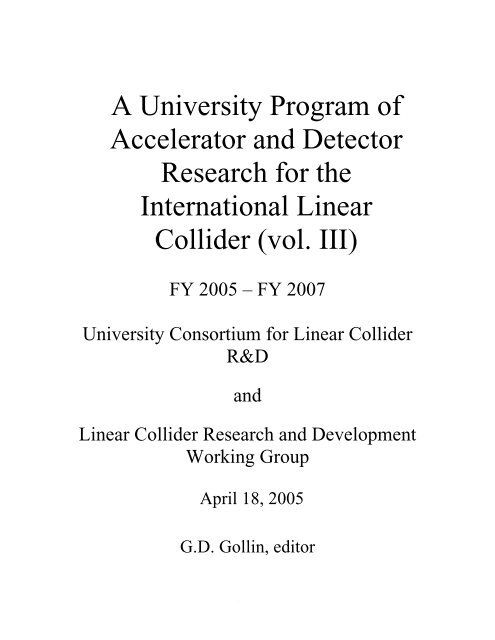
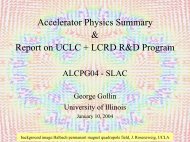
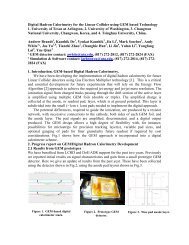
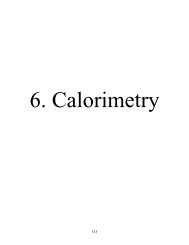

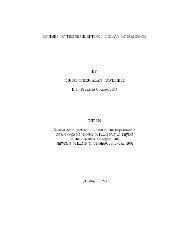
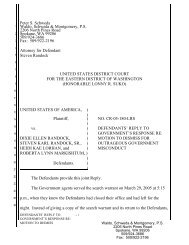
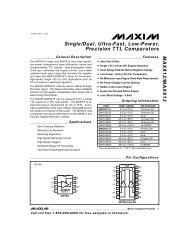
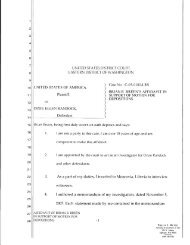
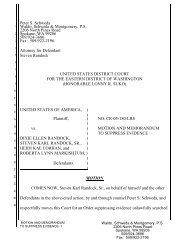
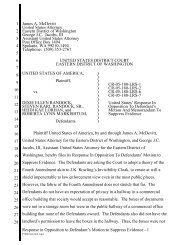
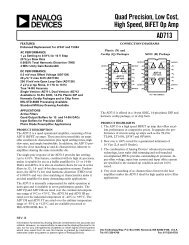
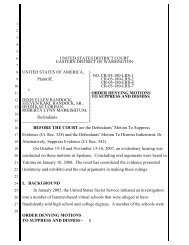
![Linear Collider [Accelerator] Overview](https://img.yumpu.com/33867705/1/190x143/linear-collider-accelerator-overview.jpg?quality=85)
